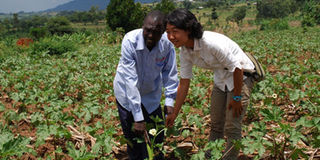Prime
Okra: Discovering the potential as a cash crop

A farmer and a researcher in an okra garden in Manafwa, one of the areas where it grows well. FILE PHOTO
What you need to know:
There is a small market and limited supply domestically, but a bigger potential as an export commodity.
Okra is a seed pod vegetable used in salads, soups and stews due to its spicy taste. The pods can also be boiled or fried and eaten as a vegetable. It is a rich source of many nutrients, including fibre, Vitamin B6 and folic acid.
The plant can be grown on a wide range of soils provided they are fertile and well-drained and in areas which are warm with moderate rainfall. If the soil is not fertile, compost manure should be applied.
Demand
It is a fast-growing crop, which takes between 50-60 days to first harvest. But, despite being a fast growing and high-value crop, it is still grown by few farmers in Uganda.
Most of the okra is for local consumption and is largely found in the northern parts of the country. There are some initiatives to produce it for export in Gulu, Mubende, Mityana and Manafwa districts but this is on a small scale.
Mr James Kanyije, a vegetable and fruit exporter, says local and foreign market demand is increasing steadily though many farmers are not aware of this.
So, few venture into growing it as many prefer to grow traditional vegetables like tomatoes, whose farming practices they are aware of.
Okra can be grown by sowing seeds directly into the ground and the planting should be done during warm periods.
If a nursery bed is set up, it is advisable that thorough watering of seedlings is done an hour before transplanting.
Seeds
The seeds can be bought from farm supply shops at Shs2,500 a packet but, as Kanyije adds, many of the okra seeds sold on the local market are of poor quality.
“We lack genuine okra seeds in Uganda which results into poor grade okra that fetches low prices on the international market. Good quality seeds from abroad are expensive and many farmers cannot afford to buy them.”
Okra can be attacked by insect pests and diseases like silver leaf whitefly, rough bollworm, looper caterpillars and green vegetable bugs.
Aphids and mites may also occur. These insects sucking the sap of the leaves, which results in yellowing, cupping and browning. This is often called hopper burn.
In Uganda, two varieties are grown and these include Pussa sawwani (Indian) and Spanless okra (Mexican). Kanyije says the Indian variety is the most marketable because it is what Asians, who are the major consumers, prefer.
Mr David Lusse, a vegetable and fruit seller in Nakasero market in Kampala, says the market supply of okra is small and the local demand is still low.
Harvest
“A kilo of first-grade okra goes for Shs8,000 while the lower grade is at Shs5,000 but the price can go up to Shs12,000 a kilo when the supply is very low,” Lusse says.
In order to get high-grade okra, a farmer is advised to pick the pods when they are about three inches long.
From an acre, a farmer can pick 400 boxes of okra a week. Harvesting of the tender pods should be done carefully by cutting them from stalks in a way that does not bruise the pods.
In case of producing for export, a cold chain is essential. The pods should be put in refrigeration as soon as possible after harvest to preserve quality. Kanyije exports to UK and sells a 5kg box at £8.50 (Shs 33,345).
Since okra is harvested over a long period, a farmer has to control weeds by mulching or weeding. The former is better is better because it suppresses the weeds while at the same time warming the soil and encouraging plant growth.




